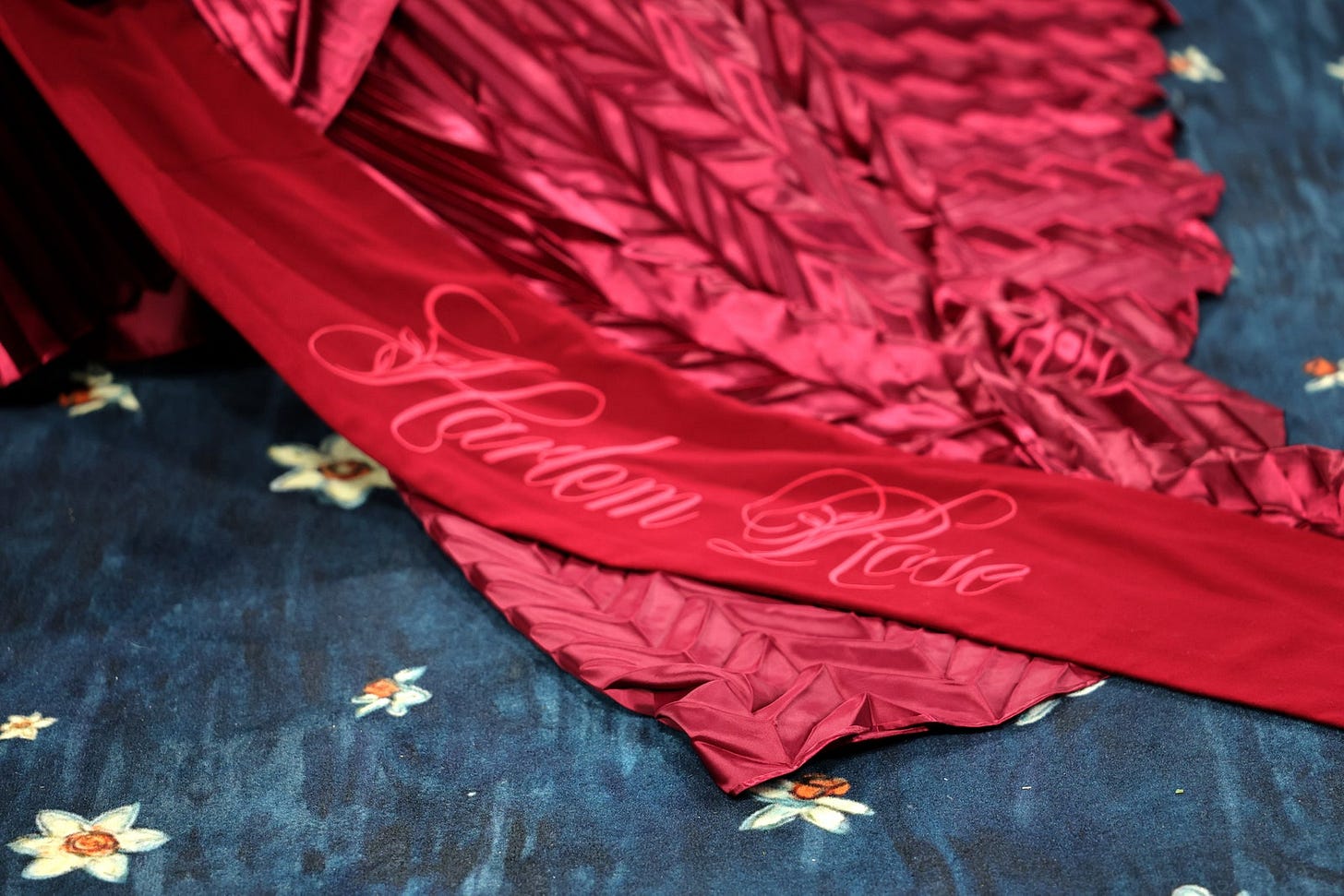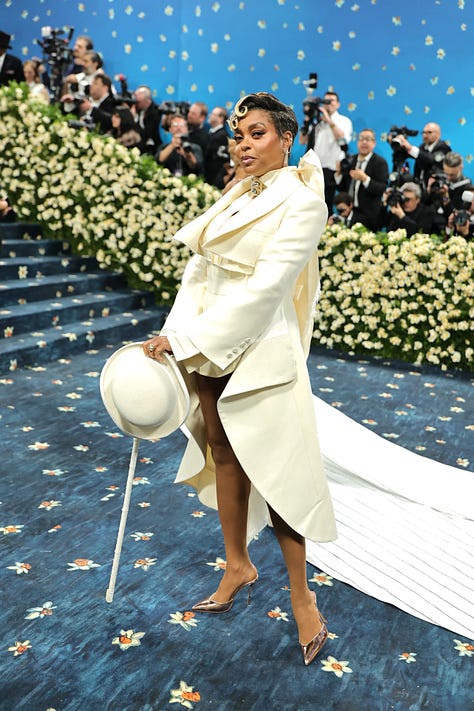#3 Personal Hell in the Harlem Renaissance: Gladys Bentley’s Sartorial Responses to Respectability
I’ve seen Gladys Bentley come up in conversations around Black dandyism and I think that’s an appropriate place for her to be especially since she favored menswear. Learn more about her fashion here.
So maybe you were paying attention to this year’s Met Gal. It’s based on the exhibit Superfine: Tailoring Black Style curated by guest curator Monica Miller author of Slaves to Fashion: Black Dandyism and the Styling of Black Diasporic Identity.
The dress code was “Tailored to You” with a focus on dandyism. Dandyism is a process of remaking and creating identity, and if you read the last section, you’ll know that the Harlem Renaissance was also a process of recreation. So many references were made to Harlem or the Harlem Renaissance during the Met Gala.

AND THERE WERE SO MANY WHITE SUITS



If you want to hear more about my thoughts on this year’s met gala let me know,blog post maybe?
Here’s the next section, discussing lesbian tomboys and some of how a suit became a lesbian symbol…
THE SARTORIAL SCIENCE OF LESBIAN MASCULINITY IN THE LATE HARLEM RENAISSANCE
Crafting Visual Lesbian Identification
Bentley remained marginalized for more reasons than just her sexuality. In the section of her Ebony Magazine article titled, “She Was an Unwanted Child,”Bentley writes, “It seems I was born different…In later years, I learned that‘different’ people are made, not born.”1 Bentley was right in her idea that different people are made. The constructions of race, gender, and sexuality were systems of oppression she was born into. Despite refuting her previous claim of being born that way, she still navigated the world as a fat, darkskin, sometimes-lesbian,sometimes-woman born to a working-class family. Due to the nature of race,gender, size, and class in the US she would have been likely to experience social isolation whether she was a lesbian or not.
Bentley’s essay is published in 1952, three years after Claudia Jones, a Black communist writer, published “An End to the Neglect of the Problems of the Negro Woman.” It is here that Jones refers to Black women as “the most oppressed stratum of the whole population” because they are oppressed “as workers, as Negroes, as women.”2 This is the oppression that Bentley was navigating whether she named it or not. Bentley worked in nightclubs to earn a living and some of her living was earned based on being a spectacle for white people who wanted to see how the “other side” lived. However, her celebrity status did provide some cushion and as a result gave her an opportunity to express sexual autonomy on stage in a way that Black women would not have been able to do previously. The precarious nature of Black womanhood in the US made Bentley vulnerable to expectations of white society and the emerging respectability politics prevalent in the Black community.
Respectability served as a way for Black women to go about self-definition and fight against racist and sexist stereotypes. There was a large emphasis on everyone doing their part for the good of the race, an attitude that was exemplified during the Harlem Renaissance. Respectability politics, as defined by African-American women’s history scholar Evelyn Brooks Higginbotham,“emphasized reform of individual behaviour and attitudes both as a goal in itself and as a strategy for reform of the entire structural system of American race relations.”3 Although Alain Locke didn’t use the language of “politics of respectability” this was a crucial part of the Harlem Renaissance. The Women’s Convention, an organization that allowed Black Baptist women to express themselves and problem solve for racial justice, placed great importance on“temperance, cleanliness of person and property, thrift, polite manners, and sexual purity.”4 During the Harlem Renaissance, Bentley did not embrace ideas of thriftiness, polite manners, and sexual purity. She had (probably very expensive) white tails to perform songs openly talking about sex acts and married another woman.
Bentley’s preference for masculine clothing began when she was young. In her personal essay, Bentley spends a lot of time describing how her childhood affected her life. She writes, “I think I began wearing their clothes [her brothers’], feeling that I was getting even with them, but soon I began to feel more comfortable in boy’s clothes than in dresses.”5 Soon after this, Bentley was forced to wear more traditionally feminine clothes, “middy blouses and skirts”. From this reflection, we know that wearing men’s clothing was a matter of comfort for Bentley. She didn’t start her performance era with an all-white ensemble, but by 1930, Carl Van Vetchen had given her a “white tuxedo” that was likely the white tails she was featured in.6 Van Vetchen likely picked up on Bentley’s masculine style and chose masculine formal wear instead of an evening dress for Gladys Bentley.
Gladys Bentley’s contemporary Ma Rainey had a famous song called,“Prove It on Me Blues”. Ma Rainey, sings a song about going out with a woman, losing her, and public speculation about her lifestyle. She sings, “They must’ve been women, ‘cause I don’t like no men/It’s true I wear a collar and a tie”.7 This song, released in 1928, already shows an association of not liking men or being a lesbian and wearing a collar and a tie. “Collar” in this case refers to a men’s shirt similar to what is called a buttoned down shirt. Lesbians involved in underground subcultures in the US and Europe had already adopted tuxedos and sometimes monocles as markers of lesbian identity.8 Bentley would not have been blind to the public’s perception of her as a performer, especially considering the prevalence of Harlem gossip columns. By engaging with the current lesbian fashion of the time she was able to proclaim affiliation to that group.
Bentley’s suit was visual identification and resistance to heterosexual standards. When a man wears a suit it becomes a symbol of restraint representing a public self. This contrasts a private self that would be more expressive and less concerned with appropriate social behavior. Sociologist Ruth P. Rubinstein writes, “An essential element of male dress that is symbolic of holding in one’s feelings is the neck cloth or tie.”9 For men in business, it was essential for them to maintain a professional identity that was not concerned with personal matters. However, the bow tie that Bentley wore as a female blues singer would have emphasized her personal life since it read as a lesbian symbol on her. While many queer people in the Harlem Renaissance chose not to make their sexuality public, Bentley’s tie stood as a clear marker of her sexuality that she proclaimed during her performances. Her tie as an object of self expression rejected the politics of respectability that discouraged Black women appearing as sexual. She created the persona both on and off stage of a confident lesbian who was able to perform stories of traditional relationship issues. Her songs regularly depicted abusive relationships, cheating, lust. Bentley regularly performed raunchy renditions of popular songs as well. By performing in this manner and wearing a tie, she helped to increase the associations of lesbians and ties. It would have been “generally recognized as a sign by those who wear it” as being a sign of lesbianism.10
Bentley writes, “One of the unique things about my act was the way I dressed. I wore immaculate white full dress shirts with stiff collars, small bow ties and skirts, oxfords, short Eton jackets and hair cut straight back.”11 In her first nightclub position, she literally assumed the male role because the previous pianist had been a man. Many people interpreted Bentley to be a male impersonator or drag king, and she is still referred to as a drag king on websites celebrating queer history. What distinguished Bentley from other male impersonators of the time is that she dressed the same on and off stage. Wilson details, “she was a well-known figure in the community, she only wore men’s clothing in public, and she married a white woman in a highly publicized New Jersey civil ceremony.”12 While drag performers would only wear clothes from the opposite sex during their performances, Bentley did it all the time. This is understood as Bentley proudly embracing her lesbianism.
By the McCarthy era of the 50s, Bentley was no longer proud to be alesbian. She denied it in her 1952 personal essay “I Am a Woman Again” in Ebony Magazine. The terms “lesbian” and “woman” were oppositional for much of Bentley’s life. Because lesbians were viewed as a “third sex” or“male-impersonators” it was important to announce that she was a woman which implied heterosexual and renounce anything that would have complicated herposition as a woman. Gendered tensions in Bentley’s life began before she was born. In the conclusion of the first section of Bentley’s essay, she writes, “But no matter how happy I am, I am still haunted by the sex underworld in which I once lived. I want to help others who are trapped in its dark recesses by telling my story.”13 Although Bentley does not detail what specifically she went through, she lived in a society that viewed same-sex relationships as shameful.
Gladys Bentley, "I Am a Woman Again, " Ebony 7, no. 10 (August 1952), available from https://queermusicheritage.com/bentley6.html.
Claudia Jones, “End to the Neglect of the Problems of the Negro Woman!” in Political Affairs, (New York, NY: National Women’s Commission, C.P.U.S.A., 1949), 4.
Evelyn Brooks Higginbotham, “The Politics of Respectability, ” in Righteous Discontent: The Women’s Movement in the BLack Baptist Church 1880-1920 (Cambridge, MA: Harvard University Press, 1993), 187
Higginbotham, “The Politics of Respectability, ” 193
Bentley, Ebony.
Wilson, Bulldaggers, Pansies, and Chocolate Babies, 176
https://genius.com/Ma-rainey-prove-it-on-me-blues-lyrics
Rebecca, Kennison, “Clothes Make the (Wo)man: Marlene Deitrich and Double Drag,” in The Journal of Lesbian Studies, 6:2, 4.
Ruth P. Rubinstein, Dress Codes: Meanings and Messages in American Culture, (Westview Press, 1995) 41.
Rubinstein, Dress Codes, 7
Bentley, Ebony Magazine, 94
Wilson, Bulldaggers, Pansies, and Chocolate Babies, 156
Bentley, Ebony Magazine, 93


